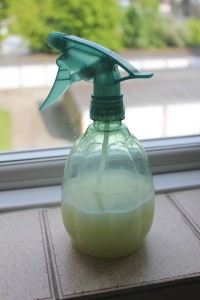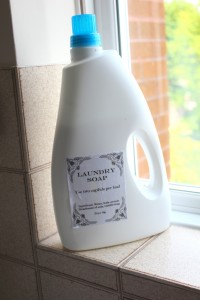Recently, I posted about my plans to trim down some of our living expenses but without returning to my maniacally frugal ways. I wanted to report on how it’s going!
Before my new plan, on our weekly shops we were routinely spending about £10-15 more per week than we ought to be to stay on our budget. The ‘weekly shop’ includes food, household items like toilet roll and cleaning supplies, and toiletries. So, my goal was to change how I shopped as well as trying to find some more frugal options for the items that seemed the most expensive. I’m pleased to say that, at the end of May, we came out almost exactly on budget. We went about £5 over, but given that my initial goal included sanity, I am not stressing out over this slight overage. So there!
Mike asked me at one point what had changed that was keeping us on budget. I actually struggled to say, just then, what it was. We already practiced the usual ways of keeping budgets down: we didn’t buy alcohol, didn’t buy frozen or ready meals (or only rarely), didn’t eat large quantities of meat, and didn’t use expensive brands of anything. So what did change?
The main changes were all small in themselves. Over the last couple of months, I’ve slowly been doing a ‘review’ of the things I use regularly and investigating whether there are cheaper or better options. Actually, that process has been a pretty healthy one, I think, because it’s easy to stick to old habits without considering that there might be better ways of doing things. I’m sad to say, I did not discover any miracle solutions that could ‘slash your grocery budget by £10 a week’. I simply focused on carving off small amounts of money here and there by shopping at the local market, buying in bulk, opting for cheaper brands, taking purposeful (instead of ad hoc) advantage of multi-buy offers, or making homemade replacements.
You’ll remember, though, that one of my goals was to cut costs sanely. I did keep in mind that I didn’t want to compromise our health by doing anything crazy (been there, done that), or compromise our sanity by being unrealistic. Though I didn’t formulate this to myself in so many words until now, the principle I gradually developed for choosing where to save and spend was this:
Spend money where it matters
Cut costs where it doesn’t
I could actually have slashed our budget much more than I did, if I had ditched some of the items where I spent more than the bare minimum because I judged it was worth it. Without going into all the details, there are certain types of food where I do discriminate (to some degree) about quality and am willing to pay a little more if it seems to me that the increase in quality is worth the money. However, I also realised that, in some things, I habitually spent money on a more expensive item when there was no discernible gain in quality, other than a purely psychological idea associated with a brand name or packaging.
This enterprise began as one solely intended to save money, but along the way I’ve actually had a lot of fun, because it’s forced me to read labels, learn new things and experiment. I even exercised my love of spreadsheets to make one that calculates the cost per gram and millilitre of a whole host of ingredients, so that I can input recipes and find out the exact cost to compare…mwahaha…okay, I can feel the craziness coming on again, so I won’t go on!
Seriously, though, since beginning the saving-money enterprise I’ve had fun learning to make all kinds of things:
- Cleaning spray
- Laundry detergent
- Popcorn from scratch in a normal saucepan (maybe everyone does this and I don’t know it, but it was new to me)
- Homemade drinks
- Lip balm
- Reusable cleaning cloths (not rocket science, just old clothes cut up, but I had never bothered to do it before!)
I’ve also learned to cook rice and beans without burning them! My mother did teach me this many years ago, but over time and with the accumulation of bad habits, I had lost the skill.
There has been only one major failure so far, which was the taco seasoning mix. It turns out that cayenne chilli powder and mild chilli powder are not the same thing. We ate a lot of really spicy soup as a consequence of not learning that lesson sooner!
For me, this was a fun challenge, and although it took some time and research, I considered it a worthwhile use of my time: both because it represented a financial contribution to our family, and because I figured that it would give me some good skills, knowledge and habits for the future.




Popcorn from scratch is the best! 🙂
I don’t know how practical this is where you are – and given what you need to make it – but it’s just coming into season for elderflowers and elderflower cordial is fun to make. You just make a really dilute sugar syrup, get it hot and pour it over the heads, then fix it with either citric acid (cheap, but hard to find) or masses of lemons (expensive, but easy to find and not too bad if you don’t make a big batch). It will freeze, too. My mum makes it every year because she lives near to where a lot of the commercial stuff is grown.
Elderflower cordial is a great idea, Lucy. I just got some nice glass bottles at the charity shop and was wondering if there were any nice summer drinks I could make. I’ve encountered other recipes with citric acid; maybe it’s time to hit Amazon…
Just saw this! Pretty bottles always tempt me too. 🙂
I have been the popcorn-making person in my family for years. Not sure if I still hold that post, but I did it in a pot on the stove, with oil (less than the popcorn package says is needed, and without bothering to test one kernel first). It seemed to me that a lot more people would do it that way if they only knew how easy and fun it could be. (However, I do think not everyone would like my popcorn; sometimes I eat it entirely plain, and even when I add things to it, it’s not like I dump loads of butter on it.)
That’s how I’ve been making it, too – just oil in a pan. We don’t have a microwave, so microwave popcorn wasn’t an option, but I guess the only homemade kinds I’d ever seen were done with a hot-hair popper or in a special popcorn popper which had a blade to move the kernels around. But you’re right, it’s very easy and fun on the stove. I just never learned how before!
Since our move to Australia, I have had to learn these things all over again. They don’t really have microwave popcorn in AU (and we don’t own a microwave) so we learned to make popcorn from scratch as well. I actually like it more since you know exactly how much salt you are eating.
Unfortunately veggies are the most expensive food group and meat is the least expensive in AU, and therefore I have had to learn how to make relatively decent healthy meat dinners. Splurging for me at the grocery store is buying a green pepper- $4.00 each!
I much prefer homemade popcorn to microwave, too. It’s less salty and artificial-tasting.
I really can’t imagine trying to cook with more meat and less vegetables. It’s pretty counterintuitive! One thing I’ve realised this month is that the strategies for being frugal have to change depending on where you are; a lot of the advice I’ve found online actually doesn’t work in the UK, and I’ve had to translate A LOT of recipes!